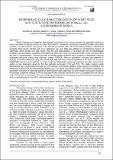| dc.contributor.author | Bernard M Gichimu, Barack O Owuor, Gideon N Mwai, Mathews M Dida | |
| dc.date.accessioned | 2020-09-01T08:44:56Z | |
| dc.date.available | 2020-09-01T08:44:56Z | |
| dc.date.issued | 2009 | |
| dc.identifier.citation | 33 | en_US |
| dc.identifier.issn | 1990-6145 | |
| dc.identifier.uri | https://repository.maseno.ac.ke/handle/123456789/2646 | |
| dc.description.abstract | Genetic diversity and relatedness were assessed among three most common commercial watermelon cultivars in Kenya; one newly introduced commercial cultivar from the U.S., one Kenyan landrace and one wild (Citrullus colocynthis) accession. The six accessions were grown in the field for two seasons under sub humid tropical conditions. Randomized Complete Block Design (RCBD) with three replications was used. Data was collected on morphological features of watermelon which include vine, leaf, flower, fruit and seed characteristics. A descriptor list with 21 morphological (qualitative and quantitative) characters was adopted from Diez et al., (2005) and Jarret and Griffin, (2007) and was refined and used in characterization. The data was used to calculate genetic similarity and to construct a dendrogram using the unweighted pair-group method with arithmetic average (UPGMA). Data on quantitative characters was subjected to Analysis of Variance (ANOVA) using SAS statistical package and effects declared significant at 5% level. The procedure PRINCOMP was then used to perform a principle component (PC) analysis using six quantitative variables and accessions plotted on two dimensions using the first two principle components (PC1 and PC2). The cluster analysis results demonstrated high morphological diversity (54-42%) between unimproved accessions (wild accession and landrace) and commercial cultivars and low morphological diversity (8-27%) among commercial cultivars. The ANOVA conducted on quantitative characters of cultivated accessions demonstrated highly significant variation between accessions. Results of the principle component analyses for the six quantitative traits indicated that the first two PCs explained 68% and 29% (a total of 97%) of the total variation. The low morphological diversity observed among commercial cultivars emphasizes the need to expand the genetic base of the cultivated watermelon in Kenya. | en_US |
| dc.publisher | ARPN Journal of Agricultural and Biological Science | en_US |
| dc.subject | watermelon; Kenya;morphological diversity; cultivars;landrace; wild accession | en_US |
| dc.title | Morphological characterization of some wild and cultivated watermelon (Citrullus sp.) accessions in Kenya | en_US |
| dc.type | Article | en_US |

